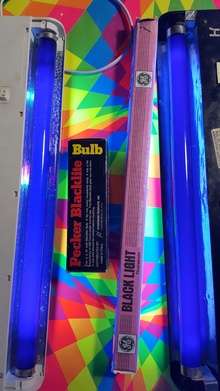Blacklight poster

A blacklight poster is a poster printed with inks which fluoresce under a black light.[1] The inks used contain phosphors which cause them to glow when exposed to ultraviolet light emitted from black lights.[2][3]
The 1960s gave birth to the pervasive use of illegal drugs mainly hallucinogenics such as LSD (lysergic acid diethylamide), mescaline, and marijuana.[4] With the ability to glow and vibrate under ultraviolet light, the posters could simulate the sensations and visual distortions one experienced during an acid trip.[5]
In the United States, blacklight posters emerged as part of the psychedelic fashion scene between 1967 and 1969.[6] Since then, the art form has gone out of fashion and is generally viewed as a relic of the 1970s.[7]
Although blacklight posters have continually been produced since the 1960s, there has been a resurgence in popularity since 2007 as blacklight and glow-in-the-dark parties have become more popular. As of 2014, there are five companies actively producing new and classic flocked blacklight posters in a wide range of content, including music, nature, and pop culture. The black parts of these posters are overlaid with black flocking, which gives it a velvet feel, and these are often referred to as velvet posters.
References
- ↑ Lincoln, Don (2004), Understanding the universe: from quarks to the cosmos, World Scientific, p. 23, ISBN 9812387056
- ↑ McCleary, John Bassett; McCleary, Joan Jeffers (2004), The Hippie Dictionary: A Cultural Encyclopedia (And Phraseicon) of the 1960s and 1970s, Random House Digital, Inc., p. 55, ISBN 1580085474
- ↑ Harris, Tom (2002), How Black Lights Work (1st ed.), HowStuffWorks.com, p. 1
- ↑ Moss, Gary (2003). Hippie Artifacts:Mind Blowing Stuff to Collect. Shiffer Publishing LTD&Design. p. 72url=http://www.schifferbooks.com/hippie–artifacts–mind–blowing–stuff–to–collect–1573.html. ISBN 0-7643-1758-X.
- ↑ Donahue, Daniel (October 1, 2009). Ultraviolet 69 Classic Blacklight Posters from the Aquarian Age and Beyond. China: Abrams Image. p. 6. ISBN 0-8109-7999-3.
- ↑ Menand, Louis (2003), American Studies, Macmillan, p. 173, ISBN 0374529000
- ↑ Campbell, Drew (2004), Technical Theater for Nontechnical People (2nd ed.), Skyhorse Publishing Inc., p. 122, ISBN 1581153449